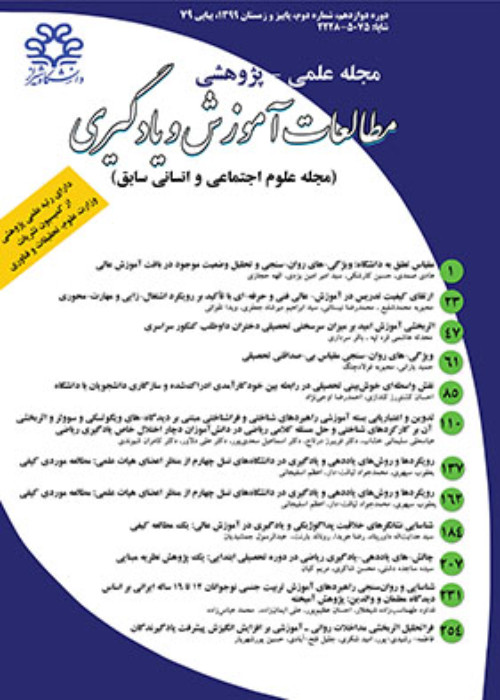Measuring the Teacher Education Social Studies Critical Thinking Skills and Dispositions in Iran
Author(s):
Abstract:
IntroductionCivic education is an academic area designed to encourage the development of good citizens. Explicit attention to these societal assumptions leads to a more viable definition of social studies as that part of the school’s general education program which is concerned with the preparation of citizens for participation in a democratic society. Success in handling the social studies implies success in stimulating critical thought. The overriding purposes must be, and therefore will be, the development of good persons and the stimulation of the search for truth. Unfortunately, we speak more often of the development of good citizens and the teaching of truth. therefore teachers must model critical thinking for students and provide numerous opportunities for students to engage in critical thinking. This Study attempts the Measuring of Critical Thinking Skills and dispositions in Teacher Education Social studies in Iran. This study followed Delphi Report in critical thinking is defined as: "We understand critical thinking to be purposeful, self-regulatory judgment which results in interpretation, analysis, evaluation, and inference, as well as explanation of the evidential, conceptual, methodological, criteriological, or contextual considerations upon which that judgment is based. CT is essential as a tool of inquiry. As such, CT is a liberating force in education and a powerful resource in one's personal and civic life. While not symonymous with good thinking, CT is a pervasive and self-rectifying human phenomenon. The ideal critical thinker is habitually inquisitive, well-informed, trustful of reason, openminded, flexible, fair-minded in evaluation, honest in facing personal biases, prudent in making judgment, willing to reconsider, clear about issues, orderly in complex matters, diligent in seeking relevant information, reasonable in the selection of criteria, focused in inquiry, and persistent in seeking results which are as precise as the subject and the circumstances of inquiry permit. Thus, educating good critical thinkers means working toward this ideal. It combines developing CT skills with nurturing those dispositions which consistently yield useful insights and which are the basis of a rational and democratic society."(Facione, 2009).Research Questions1. Whats is the rate of disposition to critical thinking of teacher education center's instructor and students?2. Whats is the rate of critical thinking skills of teacher education center's instructor and students?3. Is there a significant difference between students year of education in CT?4. Is there a significant difference between students gender in CT?5. Whats is the interaction effects between gender and year of education in critical thinking among students?MethodTo This end, a cluster random sample of 313 students and 33 Instructor members were selected and implemented the following scales: California Critical Thinking Skill Test (CCTST) and California Critical Thinking Disposition Inventory (CCTDI). Subscales for CCTDI: Open-mindedness, truth-seeking, analyticity, systematicity, CT-Confidence, Inquisitiveness and Cognitive Maturity. Also subscales for CCTST: analysis, evaluation, inference, deductive reasoning, and inductive reasoning. Cronbach’s alpha coefficients for determining the reliability for CCTDI and Kuder Richardson – 20 for CCTST were applied. Discussion and ConclusionThe purpose of the study was to measuring critical thinking based on Facione model that critical thinking including cognitive skills and dispositions. Totally, The gathered data were analyzed and the following were found:A) Students and instructors dispositions were weak.B) Students and instructors skills were mediate.C) Boy students showed strengths in truth-seeking and girl students in cognitive maturity. D) Freshman students showed strengths in inquisitiveness.E) The Interaction effects gender and year of education was not significant in CCTDI and CCTST.
Language:
Persian
Published:
Studies in Learning & Instruction, Volume:2 Issue: 1, 2011
Page:
141
magiran.com/p966258
دانلود و مطالعه متن این مقاله با یکی از روشهای زیر امکان پذیر است:
اشتراک شخصی
با عضویت و پرداخت آنلاین حق اشتراک یکساله به مبلغ 1,390,000ريال میتوانید 70 عنوان مطلب دانلود کنید!
اشتراک سازمانی
به کتابخانه دانشگاه یا محل کار خود پیشنهاد کنید تا اشتراک سازمانی این پایگاه را برای دسترسی نامحدود همه کاربران به متن مطالب تهیه نمایند!
توجه!
- حق عضویت دریافتی صرف حمایت از نشریات عضو و نگهداری، تکمیل و توسعه مگیران میشود.
- پرداخت حق اشتراک و دانلود مقالات اجازه بازنشر آن در سایر رسانههای چاپی و دیجیتال را به کاربر نمیدهد.
In order to view content subscription is required
Personal subscription
Subscribe magiran.com for 70 € euros via PayPal and download 70 articles during a year.
Organization subscription
Please contact us to subscribe your university or library for unlimited access!


